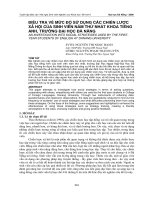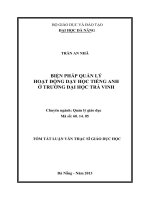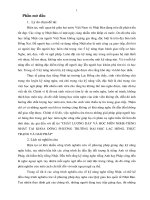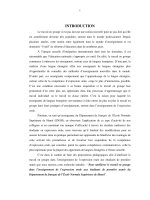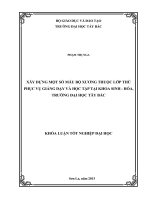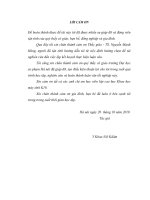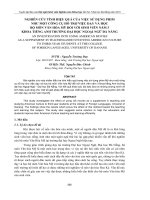khảo sát các kỹ thuật dạy môn biên dịch tại khoa tiếng anh trường đại học tây nguyên
Bạn đang xem bản rút gọn của tài liệu. Xem và tải ngay bản đầy đủ của tài liệu tại đây (613.85 KB, 70 trang )
Hoang Khanh Bao
Digitally signed by Hoang Khanh Bao
DN: cn=Hoang Khanh Bao, o=Taynguyenuni,
ou, email=, c=VN
Date: 2010.11.03 18:27:18 -07'00'
MINISTRY OF EDUCATION AND TRAINING
HUE UNIVERSITY
COLLEGE OF FOREIGN LANGUAGES
--------
HOANG KHANH BAO
EXPLORING CLASSROOM TECHNIQUES
FOR TEACHING TRANSLATION IN
ENGLISH DEPARTMENT AT TAY NGUYEN
UNIVERSITY
MA THESIS IN EDUCATION
HUE, 2010
i
MINISTRY OF EDUCATION AND TRAINING
SUBCOVER PAGE
HUE UNIVERSITY
COLLEGE OF FOREIGN LANGUAGES
--------
EXPLORING CLASSROOM TECHNIQUES
FOR TEACHING TRANSLATION IN
ENGLISH DEPARTMENT AT TAY NGUYEN
UNIVERSITY
FIELD OF STUDY: THEORY AND
METHODOLOGY OF ENGLISH TEACHING
CODE: 60.14.10
MA THESIS IN EDUCATION
SUPERVISOR: PHAM HOA HIEP, D.Ed.
HUE, 2010
ii
B
GIÁO
C VÀ ÀO
I
TR
C HU
I
C
--------
HỒNG KHÁNH
O
I NG
O
O SÁT CÁC
THU T
Y MƠN
BIÊN CH
I KHOA TI NG ANH
TR
I
C TÂY NGUYÊN
CHUYÊN NGÀNH: LÝ LU N VÀ
C MÔN TI NG ANH
MÃ S : 60.14.10
LU
C
NG
IH
TI N
O
PHÁP
C
NG D N KHOA
C:
M HOÀ HI P
HU , 2010
i
C
Y
STATEMENT OF AUTHORSHIP
I hereby acknowledge that this study is mine. The data and findings
discussed in the thesis are true, used with permission from associates and have not
been published elsewhere.
Author
Hoang Khanh Bao
ii
ACKNOWLEDGEMENTS
This thesis would not have been possible without the encouragement and
whole-hearted assistance of many people.
Firstly, I owe my deepest gratitude to my supervisor, Dr. Pham Hoa Hiep,
whose encouragement, guidance, and support from the initial to the final level has
enabled me to overcome many difficulties and develop my research skills.
It is an honor for me to extend my special thanks to all the staff, especially,
the teaching staff at Hue College of Foreign Languages. Without their help and
encouragement, I would not have accomplished my thesis.
My special thanks would also go to the teachers and students who have
participated in this project. Without their assistance, I would not have been able to
collect valuable data for the project.
I owe deeply my family, especially my parents, my wife, and my brother,
whose continuous encouragement, support, and love has helped me pass through
insurmountable difficulties during my project.
Finally, I would like to show my gratitude to all my classmates whose
encouragement and support have helped lift up my spirits during the time I
conducted this study.
iii
TABLE OF CONTENTS
Contents
Pages
SUBCOVER PAGE...............................................................................................ii
STATEMENT OF AUTHORSHIP ......................................................................ii
ACKNOWLEDGEMENTS .................................................................................iii
TABLE OF CONTENTS ...................................................................................... 1
LIST OF TABLES................................................................................................. 4
LIST OF FIGURES............................................................................................... 5
ABSTRACT ........................................................................................................... 6
CHAPTER I: INTRODUCTION ......................................................................... 7
1.1.
Background of the Study ............................................................................7
1.2.
Aims of the study. .................................................................................... 10
1.3.
Scope of the study .................................................................................... 10
1.4.
Significance of the study .......................................................................... 10
1.5.
Structure of the study ............................................................................... 10
CHAPTER II: LITERATURE REVIEW .......................................................... 12
2.1. Introduction................................................................................................. 12
2.2. Background: Language students and the translation market......................... 12
2.3. Issues on translator training ......................................................................... 16
1
2.3.1. Today’s translators’ required knowledge and skills ............................... 16
2.3.2. Current teaching methods and techniques used for teaching translation. 18
2.3.3. Translation teaching in Vietnam............................................................ 22
2.4. Chapter summary ........................................................................................ 24
CHAPTER III: METHODOLOGY ................................................................... 25
3.1. Introduction................................................................................................. 25
3.2. Research site ............................................................................................... 25
3.3. Research approach....................................................................................... 25
3.4. Research methods........................................................................................ 26
3.4.1. Classroom observations......................................................................... 26
3.4.2. Interviews ............................................................................................. 27
3.5. Participants.................................................................................................. 27
3.6. Data analysis ............................................................................................... 28
3.7. Conclusion .................................................................................................. 28
CHAPTER IV: FINDINGS AND DISCUSSION............................................... 29
4.1. Introduction................................................................................................. 29
4.2. Findings and discussions ............................................................................. 29
4.2.1. Classroom techniques currently used by teachers in translation class .... 29
4.2.1.1. Teaching materials .......................................................................... 29
4.2.1.2. Teaching techniques and methods ................................................... 34
4.2.1.2.1. Classroom arrangement............................................................. 34
4.2.1.2.2. Activities students involved ...................................................... 36
4.2.1.2.3. Teachers and students’ roles ..................................................... 38
4.2.2. Teachers’ and students’ views on the current classroom techniques ...... 40
2
4.2.2.1. Teachers’ knowledge about the social requirements of today
translation profession................................................................................... 40
4.2.2.2. Teachers’ views on the current classroom techniques..................... 42
4.2.2.3. Students’ knowledge about the social requirements of today
translation profession................................................................................... 43
4.2.2.4. Students’ views on the current classroom techniques ...................... 43
4.3. Chapter conclusion...................................................................................... 46
CHAPTER V: CONCLUSION AND SUGGESTIONS..................................... 48
5.1. Introduction................................................................................................. 48
5.2. Summary of findings ................................................................................... 48
5.2.1. Classroom techniques currently used by translation teachers at Tay
Nguyen University.......................................................................................... 48
5.2.2. Teachers’ and students views on the current classroom techniques........ 50
5.3. Suggestions ................................................................................................. 51
5.3.1. For teachers........................................................................................... 51
5.3.2. For students........................................................................................... 52
5.3.3. For administrators ................................................................................. 53
5.3.4. For future researcher ............................................................................. 54
5.4. Conclusion .................................................................................................. 55
REFERENCES .................................................................................................... 57
APPENDICES
3
LIST OF TABLES
Table 4.1: Excerpt from the Curriculum for BA in English ................................ 30
Table 4.2: Excerpt from translation course outline.............................................. 31
Table 4.3: Summary of key findings..................................................................... 45
4
LIST OF FIGURES
Figure 2.1: Socio-constructivist Classroom.......................................................... 21
Figure 5.1: Cycle of Translation Progamme Design and Development (Gabr,
2000, 17) ............................................................................................................... 54
5
ABSTRACT
This project aims to investigate the classroom techniques currently used for
teaching translation and the teachers and students’ views on the effectiveness of
those techniques at Tay Nguyen University.
Qualitative ethnographic approach was used for this study. The research methods
consisted of classroom observations and follow-up interviews. Observations of six
translation class sessions taught by two teachers were conducted. These
observations were followed up by in-depth interview with the same teachers.
Additionally, interviews were conducted with eight students representing the
student population in those classes
The results show that the translation teachers tend to employ traditional approach to
teaching translation characterized by assigning translation tasks, then providing
correction based on ready-made samples without developing students’ strategies for
translation. This model of teaching was viewed by both teachers and students as
ineffective because it failed to prepare students with the necessary strategies and
self-learning skills.
Based on the findings, it is recommended that the teachers need to explore
alternative methods for teaching translation, which could prove more useful. The
university leaders need to create and fund training events relating to translation
teaching.
6
CHAPTER I: INTRODUCTION
1.1. Background of the Study
It is undeniable that translation plays a significant role in human communication. It
has been proved through the history that translation can be traced back to the year
3000 BC (Newmark, 1988) and the need for it increases day by day due to the social
development and the demand for mutual understanding between peoples in the
world. It has recently become so effervescent an activity that the twentieth century
has been called the “age of translation” (Jumpelt, as cited in Newmark, 1988) or
“reproduction” (Benjamin, as cited in Newmark, 1988). Furthermore, the
globalization entails an increasing demand for translations thanks to the increase in
international relationship, trade, and tourism. According to Allied Business
Intelligence, the revenue of the world market in translation was US$11 billion in
1999 and supposed to be worth US$20 billion in 2004 (Sprung, 2000).
The
European Commission even values translation market at over US$30 billion
annually, and estimates its growing rate at 15 – 18 percent per year (Anobile, 2000).
In an attempt to depict the panorama of the world demand for translation in the
research on Globalization and the Translation Industry in Saudi Arabia, Fatani (n.d)
stated:
In fact, the world market in translation, already thought to be worth in excess of
£10 billion a year, barely satisfies a fraction of the demand created by a global
economy
In Vietnam, the recent open-door policy and the integration into the World Trade
Organisation have undoubtedly given impetus to the economic, political, cultural,
and social exchange with foreign countries all over the world, which, as a
consequence, has also created favourable opportunity for the development of the
translation market. It is estimated that of 600 recruiting advertisements there are
about 15-20 seeking for translators and interpreters, three times higher than the
7
number of 4-6 in comparison with those seeking for teachers on Vietnamworks.com
– the biggest website for job seekers in Vietnam (Hiep and Huong, 2007).
With such demands for translation, the way how translators are currently trained is
one of the issues that should be highlighted. As Pym (1998) stated, “the market
demand for translations is often cited as a determinant on the way translators should
be trained”, the training program and methods need to gear students to knowledge
and skills essential for their future profession as translators.
In many countries in Europe, North America, and Australia, there have been
professional training programs appropriate with the requirements of respective
translation markets (Hoang, 2007). In parallel with the program, the training
methodology has also shifted with the aim of providing students with knowledge of
translation theories and processes, skills (such as documentation techniques,
terminology, use of tools, computer resources, etc.), and areas of specializations for
translators such as law, economics, medicine, etc.(Aula.int, 2005).
In Vietnam, although the translator training at undergraduate level has also been
implemented in several colleges and universities as in Hue, Ho Chi Minh, and
Hanoi, normally, translation is one of the subjects embedded in the undergraduate
foreign language program of some other institutions and the teaching of translation
still receives little attention. In most institutions, translation teaching is taking place
informally without either “clearly-defined curricular” (Gabr, 2001) or “proper
training methodology” (Gabr, 2001). The amount of time spent on acquiring the
knowledge and skills for translation is limited as it is used for linguistic and cultural
aspects of the two languages (Thang, 2007). Of all the factors affecting translation
teaching in Vietnam at present such as lack in materials and unsystematic syllabus
design, traditional teaching method is also a problem worth considering (Thang,
2007).
The English Department at Tay Nguyen University started its training
undergraduate in TESOL in 1996. However, translation teaching has recently been
8
launched since the training of undergraduate in English language began in 2005.
Beside the deficiency in materials, methodology is seen as the most problematic
issue to teachers in the Department as most of them are young and inexperienced in
translation as well as in translation teaching. Currently, the translation teaching in
the department based on the so-called “trial-error and arbitrary teaching methods”
(Caminade and Pym, as cited in Aula.int, 2005).
From the above mentioned about translation teaching in Vietnam in general and at
Tay Nguyen University in particular, it could be inferred that the teachers are
unable to keep track with global changes of the market demand as well as training
methodology. As a result, the students will be unable to function as professional
translators because they are encompassed by unauthentic and old materials and
lagging teaching methods, thus are not well equipped with required knowledge and
skills in accordance with the changing market demand.
Despite the reality that a well-design and systematic curriculum is one of the key
factors ensuring success in translator training, it is believed that appropriate
teaching methods in which techniques employed for teaching the subject effectively
also have no small contribution to taking shape of the required knowledge and
skills for students’ future performance in translation.
As a teacher of English with deep interest in translation, I believe that exploring
classroom techniques currently used in translation classes can be a significant basis
for the development of more effective techniques which then will contribute to the
improvement of teaching and learning translation. Inspired by this, I chose to
conduct my research on current classroom techniques for teaching translation in
English Department at Tay Nguyen University. I hope my research will make some
contribution to the improvement of teaching and learning translation at my
university.
9
1.2. Aims of the study
This project seeks to investigate what classroom techniques are currently used in the
translation classes at Tay Nguyen University and how effective these techniques are
in view of the teachers and students. Based on the findings, suggestions are given
for development of more effective techniques.
This project particularly aims to answer the following questions:
1. What classroom techniques are currently used by teachers in translation
classes at Tay Nguyen University?
2. How do the teachers view these techniques in terms of effectiveness?
3. How do the students view these techniques in terms of effectiveness?
4. What suggestions are given to develop more effective classroom techniques?
1.3. Scope of the study
This study was conducted in the English Department of Tay Nguyen University.
The data were thus necessarily limited in scope, and could not be generalized to
other contexts.
1.4. Significance of the study
The project helps gain information about what techniques were currently used for
translation classes and how effective these techniques were in view of teachers and
students. On the basis of the findings, suggestions were given to develop more
effective techniques to enhance the teaching and learning of translation in English
Department at Tay Nguyen University.
1.5. Structure of the study
This study comprises five chapters:
Chapter I – Introduction – has provided some background that lead to the research.
The aim, scope, and significance of the study are also included in this section.
Chapter II – Literature review - will present the theoretical background of the study.
It focuses on the teaching of translation and its current issues.
10
Chapter III will describe the research methods employed in this study.
Chapter IV – Findings – will present the data and discuss the results of the study.
Chapter V – Conclusion and Implication – will summarize the findings and offer
some implications for teaching translation and suggestions for further research.
11
CHAPTER II: LITERATURE REVIEW
2.1. Introduction
This chapter aims to present the theoretical background of the study which tries to
picture an overview of the issues on translation market and language students. It
also provides a close look into the issues on translator training in terms of today’s
translators required knowledge and skills, current teaching methods and techniques
used for teaching translation, and translation teaching in Vietnam.
2.2. Background: Language students and the translation market
Hiep and Huong (2007) note that taking into consideration the issues of the
students and the market demands is of the decisive factors in translator training.
Therefore, an overview of what and how language students have been trained so far
and to what extent the translation market needs are significant contributions to the
study.
According to Pym (2002), since the mid-twentieth century the world has witnessed
the coming into being of series of translator training institutions in different areas of
the world, notably, in Western Europe and North America. As estimated by
Caminade and Pym in 1995and Harris and Kingscott in 1997 (cited in Pym, 2002),
the institutions might reach the number of approximately 300. In order to give the
explanation to this phenomenon, Pym (2002) assumes that it is generally because of
the economic exchange and the globalization which are animatedly taking place
throughout the world. However, Pym (2002) believes that the translator training
programmes are “context-specific” as they are dependent on the specific situation of
a particular area.
As for those in Western Europe, which are mostly at university level, place their
emphases on training conference interpreters thanks to the multilingual policies and
in response to the European unification. Whereas, in North America and Australia,
where there is a great number of immigrants, the translator training has also
developed considerably in connection with the domestic social demand for
12
community translators and interpreters. Thanks to the globalization, Asia,
especially, the Pacific Rim has also been marked as a region of rapid development
in translator training. (Pym, 1997)
Despite such worldwide effervescence, translator training is still believed to include
several problematic issues. Mossop (2003) argues that “translation schools are
inherently limited in what they can do to prepare students for the workplace…”
(Cited in Translator Training & the Real world: Concrete Suggestions for Bridging
the
Gap
–
Round
table
part
A,
retrieved
from
/>In fact, except for some famous institutions in Western Europe with their long
history specialized in translation training, mostly the translator training programmes
are offered in foreign language institutions – a model that can be seen in many of
Asian countries and even in the Eastern Europe. Thus, most of the time in the four
or five-year University level courses students are supposed to be provided with
access to the consolidation of language skills, and promotion of the awareness of
cultural differences. Even in the United States, where the formal translation
education has relatively been well-developed, the translator training programmes
are also criticized to involve the students in acquiring the second language, and
courses in translation theory are considered to provide students with knowledge of
what and why the translators are doing (Pym, 1997).
Due to the open-door policy and the recent integration into the WTO, the political,
socio-economic, and cultural exchanges between Vietnam and many foreign
countries has been manifold. This, as a result, leads to a great demand for
translation. The translator training, thus, has been shown much concern. Typically,
the translator training programmes have recently been integrated in many
Vietnamese universities and colleges of foreign languages. However, it is
regrettable that most of the current translators in Vietnam are considered to lack in
knowledge and skills to function as professional translators (Dong, 2007). The lack
in professionalism of Vietnamese translators can be claimed to be partly rooted
13
from the training. Referring to the training of translators, in the opening speech at
the conference on “Translation – Interpretation and Translator – Interpreter
Training” held in August 2007 Doctor Tran Van Phuoc – Rector of Hue College of
Foreign Languages states:
Many companies wish to recruit university graduates who can offer good quality
translation service. However, it seems that many students graduating from our
colleges and universities lack the necessary abilities and skills to function
successfully as translators. (In Huong, 2008, p. 21)
Indeed, according to Hiep and Huong (2007), without mentioning translation skills,
many Vietnamese foreign language students still face a lot of difficulties in
language skills.
As the training of translators should be targeted to the market, it is necessary that
the current requirements of the translation market be taken into consideration.
Apart from the knowledge of the two languages and cultures as well as that of the
translation theory which are considered important for students to cope with
translation jobs, whether these are sufficient for students to act as professional
translators in present-day translation market is still in question. The more the
translation market demand grows in terms of the number of the services, the more
professional it requires the translators to be in terms of knowledge and skills.
Practically, today translation market requires the translators not only to have a good
command of both source and target language but also to “bring together knowledge
and skills that belong to different disciplines, such as documentation, terminology,
desktop publishing, as well as some knowledge of specialized texts” (Aula.int,
2005).
At present, the advances in information and communication technology has great
influence on the nature of many professions including translation (Aula.int, 2005).
According to Hiep and Huong (2007), almost the translation jobs today involve
translators in making use of computer. The fact that “most of translation companies
14
nowadays require the translators to master computer-aided-translation softwares
such as Trados or Wordfast, which help accelerating and ensuring the consistency in
the translation process” (Hiep and Huong, 2007, p. 75), is considered a life or death
matter that guarantees the translators’ survival in the market. Today, as the
geographical limitation is no longer a big hindrance, “most translation services are
offered and supplied through internet” (Aula.int, 2005). The appliance of internet
does not simply take effect in exchanging texts between translators and their clients,
but also provides translators with an abundant source of terminology which then
facilitates the documentation. It is believed that without such technological tools,
translators may not earn any profits from today translation market (Aula.int, 2005;
Pym, 2009).
Knowledge and skills in information technology are not all that today market
requires. Pym (1998) claims:
Enormous quantities of texts and terminologies are fairly remote from anything like
common everyday language, seriously questioning political ideals of "all-purpose"
languages. This general phenomenon might be called "specialization"... Such
specialization has several effects on the demand for translations.
Along with the socio-economic, cultural, and political exchange as well as the
technological transfer, a wide variety of technical-specific texts that need to be
translated, thus, emerge. To meet such demand of the translation market, it is clear
that translators are destined to acquired “knowledge of the material concerned”
(Tytler, in Snell-Hornby, 1991).
It can be inferred from the above presented about the students’ background and the
translation market that in order to improve the translator training situation it is
utmost important to identify today translators’ required knowledge and skills.
15
2.3. Issues on translator training
2.3.1. Today’s translators’ required knowledge and skills
In addressing the problem of the professional translator of tomorrow, Snell-Hornby
(1991) argues that today translators should act not only as “language specialists” but
“all-round experts” as well. In order to gain such status it is vitally important that
translators should have knowledge, competence, and skills that go hand in hand
with the harsh requirements of the market. As translation is both a science and a
craft (Gabr, 2001), it certainly requires both theoretical and practical knowledge and
skills relevant to both language and translation. Yet in the scope of this research, the
followings are considered key knowledge and skills that a translator should have in
order to meet today translation market demand.
Firstly, since translation is to deal with language, it is patent that “language
competence is essential prerequisite for any translator’s work” (Snell-Hornby,
1991). In order to render meaning of a text from one language to another, translators
must have good command of both source and target languages. According to
Razmjou (2004) language skills are of the factors that constitute a good translator.
She argues that beside the ability of writing smoothly and correctly in both source
and target languages (as writing is the main job of a translator), receptive skills like
reading and listening help improve the translator’s “language intuition and make
him or her ready for actual translating”.
Translation, yet, is not simply a linguistic activity which requires language
competence only. Since the work of translating takes place in a socio-cultural
context, translation is undoubtedly a socio-cultural activity which calls for the
translator’s a broad knowledge of the norms and conventions of both source and
target cultures (Snell-Hornby, 1991, p11). Razmjou (2004) asserts that in order to
better the quality of the translation to a great extent, translators must be aware of
culture, customs, and social settings of the source and target language speakers.
Therefore, a professional translator is not only a bilingual but also a bicultural (if
16
not multicultural) person (Karamanian, 2002) who has the ability to decode and
encode not only languages but also cultures.
Practically, today translators’ required knowledge and skills go far beyond the
knowledge of languages and cultures. Laszlo and Pym (in Gabr, 2001) both agree
that translators should balance their knowledge of language with the some fields of
specialization so that they can cope with the problem of terminology in the texts to
be translated. However, in order to solve the problem of terminology, Pym (1998)
believes that it is not necessary that a translator should be highly trained specialist
in the fields concerned. In this case Pym proposes that a good translator should have
the “skills and contacts to find specific information when necessary” (Pym, 1998).
Furthermore, the intrusion of information technology into translation has lately
changed the translators’ working environment. Scheft (1991) states:
Customers increasingly use communication equipment to provide their source language
texts, and they expect the translation to be returned in a similar fashion with the text ready
for publication and produced in the specified desktop publishing format. (Scheft, 1991,
p153).
In the discussion of the “challenges of being a translator on the Eve of 21st century”
Houbert (1999) says that today translators have not only to nurture their language
skills but also to keep abreast of the information technological advances. He
metaphorically compares:
These days, hanging around trade fairs and having to admit you are still without
your own e-mail address will make you look like a would-be Formula 1 driver
cruising around in a second-hand Lada. (Houbert, 1999)
Accordingly, it is clear that computer literacy is a must for today professional
translators as it not only facilitates the translators’ communication with
geographically distant clients and provides them with access to various sources of
information (Pym, 1998) but helps translators to make sure their products are
compatible with the standards set by clients as well. Particularly, those such as word
processing, internet, email, computer-aided-translation softwares… would be
17
helpful electronic tools which ensure the translators long-term survival in today
fast-track market.
Last but not least, since a translator offers his/her services to clients, he/she is
supposed to be businessperson, thus, should have skills to handle his or her
business. To do this, the translator is forced to acquire business skills such as
marketing, negotiation, time management, and fee estimation and charging (SearlsRidge, 2000).
According to Searls-Ridge (2000), the knowledge and skills that ensure a
translator’s success can briefly be synthesized as follows:
Fluency in two languages and cultures.
Good general education in addition to the prerequisite language skills.
Above-average writing skill in target language
Excellent computer skills and a willingness to continue to learn new technology.
Good business skills including marketing, negotiating, pricing, and time management
Getting along well with others.
Knowing limitations in all of the area mentioned above.
(Cited
in
Searls-Ridge,
2000,
retrieved
from
/>Although it would take time and energy for a translator to gain those knowledge and
skills through actual work, it is believed that a sound training programme and
appropriate teaching methods surely help initiating the accumulation of the above
knowledge and skills. Therefore, taking into account the pedagogical issues on
translation such as teaching methods and techniques is a good contribution to the
preparation for students to function as professional translators.
2.3.2. Current teaching methods and techniques used for teaching translation
Although the “veteran professionals”, who were mostly autodidactic, believes that
translation can not be taught or learned (Newmark, 1991, p. 137), Azizinezhad
18
(2006) in responding to the inquiry of the teachability of translation confirms that
translation is teachable and that the teacher in teaching translation should bear in
mind the truth that he/she is teaching the two different things at the same time –
language and translation.
Today, the innovation of the educational philosophy is exerting considerable
influence on the teaching and learning process. The traditional classroom where the
teacher, like a vessel of knowledge, pouring down his/her knowledge to the passive
students is considered unlikely to create a favourable environment for acquiring
practical knowledge and skills. Accordingly, the translation pedagogy has also
received more attention. Translation teaching, however, like translation itself, is a
new profession (Newmark, 1991); the quest for the most suitable methods and
techniques used for teaching it is, at present, a matter of considerable concern.
With respect to translation teaching, there exist different viewpoints on the methods
and teaching techniques. According to Azizinezhad (2006) in teaching translation
for target language learners, it is essential for the teacher to employ the language
teaching methods conforming with the methods used for teaching translation as a
craft, thus, the techniques should be a sound combination between those for
teaching language and those for teaching theoretical and practical aspects of
translation. Specifically, in parallel with nurturing students’ target language
competence, it is required that the teacher should keep his/her students abreast of
the skills and techniques for translating.
In attempting to introduce a model approach to translation curriculum development
targeted to the market and students’ needs, Gabr (2001) confirms that “a sound
approach to translation teaching and training ought to employ methods that address
theoretical aspects of translation as well as the practical aspects of translating”.
Seen as that way, the methods he proposed include “passive and active modes of
instruction” namely lecture method, discussion, audiovisual methods, experiential
methods, role-playing, and computer-based method which, according to Gabr, are
considered to not only cover theoretical and practical aspects of translation but
19
create favourable condition for both teaching and learning processes. While such
passive mode of instruction as lecture method tends to promote the teacher’s control
and facilitates the conveying of “theories, concepts and procedures” (Gabr, 2001, 5.
Selecting teaching method and techniques, para. 3), but the role of student and
learning process, it can be used in combination with other active modes of
instruction, which encourage active learning. Discussion, for instance, enhances the
two-way interaction between teacher and students; audiovisual method, which
provides students with more vivid and enjoyable learning environment by making
use of technological tools such as overhead transparencies, films or audiotapes, etc,
can be employed to present “dynamic and complex events” (Gabr, 2001, 5.
Selecting teaching method and techniques, para. 5). Other methods like experiential
and role-playing can offer students opportunity for “self-discovery and learning”
(Gabr, 2001, 5. Selecting teaching method and techniques, para. 7), “analytical and
problem-solving skills” (Gabr, 2001, 5. Selecting teaching method and techniques,
para. 6).
Since the teaching of “purely linguistic aspects” has been replaced by that of
“translation theory and processes, and instrumental skills” (Pym, 1998), the
conventional teacher-centered classroom no longer conforms to conveying “the
wide range of professional and interpersonal skills, knowledge and competences”
that the “translator-in-training” needs to act like a professional translator in “an ever
more demanding language mediation market” (Kiraly, 2003). It can be figured out
that the methods and techniques used for teaching translation must not only reflect
the “translating activities”
(Newmark, 1991, p134) such as text analysis, word
selection, or finding solutions to the problems of “linguistic and cultural
untranslatability” (Gerding –Salas, 2000, The specific approaches, para. 3); but help
familiarize students with the translators’ real-life activities so that they are wellequipped and confident enough to enter the translation market.
Based on the socio-constructivist theories, Kiraly (2003, p. 51) proposes that:
20
